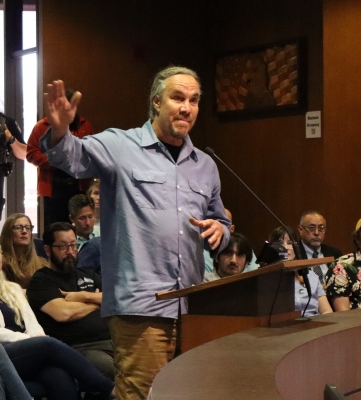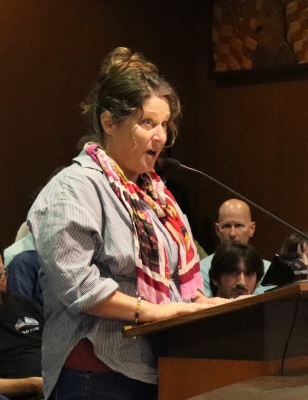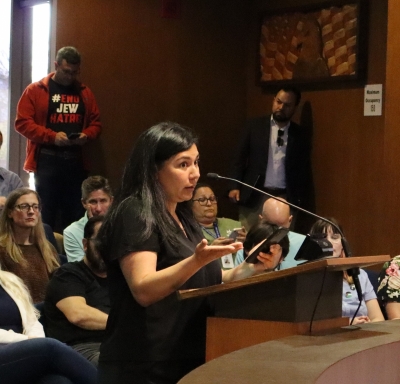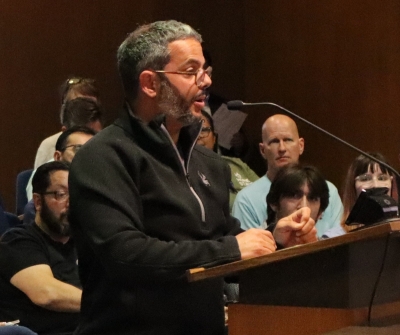By Karen Pearlman
March 27, 2025 (San Diego’s East County) -- Public water utility entity Helix Water District isn’t just about water – it’s also about energy, power and air.
On Tuesday, the district with roots dating back to 1885 got on board with the future, breaking ground at its El Cajon operations center as part of the district’s transition to a zero-emission vehicle fleet through electrification.
The $11 million electrification project will install nearly 90 high-speed vehicle chargers at the district’s operations center.
Helix Water District is transitioning 86 medium- and heavy-duty vehicles and installing nearly six megawatts of charging infrastructure aligns with San Diego Gas & Electric’s mission to support public agencies and fleet operators in meeting California’s Advanced Clean Fleets regulation and local climate action plan goals.
The estimated completion date is April 2026 – and the project is thought to be the first of its kind in California, Helix officials say.
Helix is collaborating with San Diego County Air Pollution Control District, SDG&E, a Disadvantaged Community EV Charger Rebate program and other crucial strategic allies for funding and expertise during the process of installing the electrical capacity and charging infrastructure needed for the transition.
The San Diego County Air Pollution Control District is the local government agency charged with improving the air quality in San Diego County to protect public health.
The district is electrifying its vehicle fleet to meet the state of California’s advanced clean fleet requirements. The district says it will be able to complete this project almost entirely without impacting water rates.
In 2024, the State of California’s advanced clean fleet regulation required that 50% of all new medium and heavy-duty vehicles purchased by public agencies be zero emission vehicles. That number increases to 100% in 2027.
With the regulation, public agencies will need to deploy charging infrastructure that will power their new fleets for both daily and emergency operations use.
The charging stations will not only serve the district’s fleet but will also be available to surrounding agencies to utilize during emergencies and as they work through challenges and costs to electrify their own fleets.
 “As a local public agency, we must comply with state regulations and this project needs to move forward now to take advantage of financial incentives,” said Helix Water District Board Member Mark Gracyk.
“As a local public agency, we must comply with state regulations and this project needs to move forward now to take advantage of financial incentives,” said Helix Water District Board Member Mark Gracyk.
“We’re not doing this reluctantly. (Helix has) already reduced our energy use by 15 percent and our carbon footprint by 40 percent. This project will be a model for other agencies working to electrify their fleets and help the cities we serve meet their climate action plan goals.”
The Helix operations center in El Cajon houses the majority of the district’s fleet, which transports crews responsible for the maintenance of 742 miles of pipeline, valves, hydrants and meters for its nearly 280,000 customers.
The project has been funded in part with nearly $9 million through grants and rebates, and supports neighboring public agencies as they work toward the electrification of their own vehicle fleets.
Helix received a $5.2 million grant from the SDCACPD, a $2.2 million grant from SDG&E’s “Power Your Drive for Fleets” program and an additional $1.5 million through the Disadvantaged Community Electric Vehicle Charger Rebate Program. The district will fund the remaining $2 million.
By Karen Pearlman
Photo: Rabbi Scott Meltzer said his synagogue in San Diego has twice been vandalized with antisemitic graffiti.
March 26, 2025 (El Cajon) -- The El Cajon City Council took a step toward condemning hate by unanimously voting for a resolution to adopt the International Holocaust Remembrance Alliance’s Working Definition of Antisemitism.
The City Council’s 5-0 vote Tuesday afternoon came on the heels of 40 public speakers weighing in on the resolution to condemn antisemitism, introduced earlier this month by El Cajon Mayor Bill Wells and Councilman Gary Kendrick.
“Antisemitism reared its ugly head again with the murder of 1,200 innocent men, women, children and babies by Hamas on October 7th," Kendrick said, referring to the U.S.-designated terrorist group’s attack in Israel on Oct. 7, 2023. “I have several Jewish friends who are afraid to go out in public. Jewish students have been attacked at colleges. This hate must stop. This resolution is a small step in that process.”
The IHRA’s definition of antisemitism will be used as an education resource for police and other departments in the city of El Cajon.
It reads: “Antisemitism is a certain perception of Jews, which may be expressed as hatred toward Jews. Rhetorical and physical manifestations of antisemitism are directed toward Jewish or non-Jewish individuals and/or their property, toward Jewish community institutions and religious facilities.”
The resolution includes contemporary examples of antisemitism, adopted by the IHRA on May 26, 2016, as an important tool to address antisemitism.
Wells said he was sent a social media post from a group that calls itself the “Jewish Voice for Peace,” which accused the mayor of intending to give orders to the city’s police department “to arrest anybody for a hate crime” for making a statement negative about Israel, which Wells said wasn’t true.
 Public speaker Spenser Little (right) said he didn’t agree with the resolution and felt it was an unfair “application of language” and an attempt to stop criticism of Israel. He spoke of the city’s large number of refugees from the Middle East who have emigrated to America to get away from violence.
Public speaker Spenser Little (right) said he didn’t agree with the resolution and felt it was an unfair “application of language” and an attempt to stop criticism of Israel. He spoke of the city’s large number of refugees from the Middle East who have emigrated to America to get away from violence.
“El Cajon’s full of children that are from war-torn countries watching this happen in another country, and now they can’t speak their mind freely… and the freedom of speech to say what’s happening right in front of them,” Little said. “The silencing of the community to not talk about what the truth is, (what is) happening, is what concerns me.”
 Speaker Tina Bernard (left), who said she converted to Judaism many years ago, said that those opposing this definition are doing it “because they want to continue their behaviors unchecked.”
Speaker Tina Bernard (left), who said she converted to Judaism many years ago, said that those opposing this definition are doing it “because they want to continue their behaviors unchecked.”
Bernard said that the Jewish community and others “deserve a clear definition that protects against hate, safeguarding not just Jews but the values of mutual respect and co- existence that underpin our western democracy.
“It helps our line between free speech and hate crimes --and that line has gotten way too blurred lately.”
Another speaker, Julie Litman, called adopting the IHRA language of antisemitism “not simply a symbolic act -- it’s a moral imperative.”
“Antisemitism is a present-day crisis and it’s growing,” Litman said. “Jewish communities, like all others, deserve to feel safe, respected and valued, and when we let hate go unchallenged and when we let prejudice and false accusations fester, we all suffer.”
Litman said the IHRA verbiage sends a clear message that hate will not be tolerated, “no matter what it takes, and we’re ensuring that the next generation grows up in a community that stands up against injustice and stands with those who face discrimination.
“It’s more than just about the Jewish community, it’s about our shared humanity and it’s about making El Cajon a place where everybody, regardless of their background, can live in peace.”
 Julia Gomez (right), interim managing director of the ACLU of San Diego and Imperial counties, said her group had sent a letter to the City Council urging a no vote on the resolution on antisemitism.
Julia Gomez (right), interim managing director of the ACLU of San Diego and Imperial counties, said her group had sent a letter to the City Council urging a no vote on the resolution on antisemitism.
“The First Amendment applies to all of us, including those whose positions do not align with their with their government’s political stances,” Gomez said. “Any attempt to silence their voices is patently undemocratic. The ACLU staunchly defends their rights to criticize domestic and foreign governments. The IHRA definition on anti-Semitism is overbroad and incorrectly equates protected political speech with discrimination.”
Some speakers spoke to conflating anti-Zionism -- or opposition to the Israeli state -- with antisemitism, which is the discrimination, violence or dehumanizing action toward Jews.
Jose Cortes said he was “really disappointed to see how easy and very quickly we’re moving our proposal that really kind of exceeds the scope of the local City Council.”
Cortes said the resolution “kind of reduces and kind of divorces the genuine anti-Semitism that’s happening even here in El Cajon as recently as July from the very real systems that also affect Islamophobia, racism, homophobia (and) transphobia.”
While some public speakers at the meeting shared concerns that the resolution would chill free speech, Councilman Steve Goble said he didn’t think that was the case.
The resolution also mentions the city’s commitment to protecting freedom of speech and expression.
“We need to protect people who feel threatened by their very existence,” Goble said.
Rabbi Scott Meltzer of Ohr Shalom Synagogue in the Bankers Hill area of San Diego encouraged people to read the working definition of antisemitism and read the city’s resolution.
“While criticism of Israel is sincere and legitimate in all places where it is sincere and legitimate, it cannot be used as an opportunity for antisemitism,” Meltzer said. “That is rather than people being falsely accused of antisemitic comments when they criticize Israel, we are now finding that antisemitism is being given to the community couched as anti-Israel rhetoric.
“Just recently my synagogue twice was vandalized. Clearly, vandalizing the synagogue is an antisemitic act and the comments that were made on all the buildings were anti-Israel comments.”
City Manager Graham Mitchell said the IHRA Working Definition of Antisemitism will “address antisemitism and all other forms of discrimination directed toward anyone within El Cajon.”
Mitchell said the resolution references the city’s diverse population and calls for nondiscrimination against all, including minority groups, refugees, immigrants and asylum seekers.
Although statistics on antisemitic acts in El Cajon were not available, and numbers for 2024 not tabulated, the Anti-Defamation League reported that the greater San Diego area recorded 108 incidents of antisemitic assault, vandalism and harassment in 2023, soaring to 200 percent above the previous record of 36 in 2022.
The numbers reflect a global trend as Jewish communities worldwide face have faced heightened tensions and hatred in response to the Oct. 7, 2023 massacre and ongoing conflict – as seen on college campuses, in public areas and at anti-Israel demonstrations.
 Alberto Mansur (left), a Mexican-American Jew, told the city council that “being a Jew is easy… until it’s not easy.”
Alberto Mansur (left), a Mexican-American Jew, told the city council that “being a Jew is easy… until it’s not easy.”
“It’s not easy when people hate you for being a Jew,” Mansur said. “Not because of who you are but because of what you are. Being a Jew is being hated from both the left and from the right… Adopting (the IHRA verbiage) is crucial in saving our Jewish communities from violence and discrimination especially in light of rising antisemitism today.”
The dramatic spike of antisemitic acts in San Diego included 58 incidents post-Oct. 7, 2023 (during the last 85 days of the year). The San Diego region has about 100,000 Jews, making up about 3 percent of the greater population, according to the American Jewish Committee.
The ADL also reports that antisemitic incidents across the U.S. have skyrocketed 360 percent in the aftermath of the attack in Israel. With a population of about 6.3 million, Jews make up about 2 percent of the total U.S. population.
Nicole Murray-Ramirez of the San Diego Human Relations Commission, said that “hate crimes against the Jewish community is at an all-time high.”
“Jewish students are not safe at our region’s colleges and universities, and have been threatened and harassed,” said Murray-Ramirez, who added that he also has been discriminated against as a Latino Catholic man. “Nazi hate material has been plastered around Jewish neighborhoods and temples threatening children and families. In my over 16 years of state, county and city service, I’ve never witnessed such hate as that toward the Jewish community and now more than ever, we need the IHRA definition.”
By Miriam Raftery
March 25, 2025 (Rancho San Diego) – Today, the Joint Powers Authority (JPA) for the Water Conservation will meet to weigh opens for long-term funding and stability of the Garden at Cuyamaca College.
At its Feb. 25 meeting, the board discussed future funding options after the City of San Diego’s representative Nicole Beaulieu DeSantis announced intent for San Diego to withdraw from the JPA in light of the city’s budget crisis. Helix and Otay water district representatives voiced optimism that their agencies will likely be able to fill the funding gap left by San Diego’s departure and avert having other agencies leave the JPA.
Lauren Magnusen, Director of the garden, provided good news on improvements in Garden revenues outside of the water agencies’ contributions. Large donations have come in from the Sam Ciccati Foundation and major donor Maggie Burnett.
“The numbers are a lot better than in the past,” she told the board. “We have more admissions and more events.” The Garden has 77 new members and drew over 2,500 visitors in the prior two months, she said. Events are returning, including Tomatomania in early March and the Spring Garden and Butterfly Festival May 3.
But Magnusen added, “If we want more revenue, it’s in education. For education, we need educators.”
The board eliminated the Ms. Smartyplants education programs when it took over operations of the garden from the financially troubled nonprofit Friends of the Water Conservation Garden, which has since declared bankruptcy.
Helix Water District director Brian Olney said that despite the improved revenues, without contributions of the JPA’s member agencies, “The garden would be $180,000 in the hole right now.”
A draft letter has been sent to each member water agency for review; results are expected to be discussed at today’s meeting. It proposes that short term, Helix and Otay Water Districts will share in covering the revenues lost from San Diego pulling out.
Helix representative Dan McMillan said Helix is “fully committed to an upward budget. We will cover half if the city pulls out.”
Otay representative Jose Lopez said he believes Otay is committed, adding, “We’ll give it the best shot we’ve got.”
Sweetwater representative Steve Castenada asked for a non-escalator clause to be sure no agency would be “on the hook” for higher contributions if any agencies pull out in the future. With that, he said, “We could probably get approval for more than two years.”
If increased funding doesn’t come through, the JPA would consider turning over operations of the Garden to the Grossmont-Cuyamaca Community College District.
Chancellor Lynn Neault said, “We’re fully committed to the Garden,” but cautioned that they would need at least 18 months, and preferably two years notice to take it over, since it takes time to create college-oriented educational programs.
The Chancellor praised the work of the Garden’s volunteers, who provided 1,245 volunteer hours in the prior month alone. “God bless the volunteers,” Neault said. “That’s the work of 30 people. They’re the backbone of operations—it’s astounding.:
The JPA aims to make a determination as early as April on a plan for continued funding and future operations of the Garden after the current agencies’ agreement ends June 30.
- Once someone books a ride, Via’s technology matches them with other riders headed in the same direction into one small electric vehicle – creating quick and efficient shared trips.
- Riders are directed to “virtual bus stops” (typically a short walk away from their pick-up and drop-off location), which minimizes detours and keeps trips running smoothly for everyone.
- The program will operate Monday to Friday 8 a.m. to 5 p.m. The free ride period ends April 17, after which trips will cost $2.50 each.
- Riders with mobility issues can request door-to-door services and wheelchair-accessible vehicles.
East County News Service
March 20, 2025 (El Cajon) -- The Circle Players will be performing the dinner theatre production of “Everyone’s A Critic” on April 5th at 6:30 p.m. and on April 6th at 1:30 p.m. Performances will be held in Richardson Hall, 551 Farragut Circle, El Cajon. All seats for this mystery dinner theatre show are $30 and includes a 3-course French-themed meal.
About the show directed by Joel Gossett On the brink of a famous food critic’s first bite, the staff of the exclusive French restaurant Goût de Paris has a traitor in the kitchen who appears to be bent on sabotaging the evening. You, the audience, while enjoying a delicious French three-course meal, must guess who the culprit is.
Reservations can be made by visiting the website at www.thecircleplayers.org and clicking on TICKETS
East County News Service
March 19, 2025 (El Cajon) -- Saps at Sea, the San Diego chapter of the Sons of the Desert, the International Laurel and Hardy fan organization, presents: Ollie Feigns Illness to Attend Lodge Events!
Films include Laurel and Hardy in "Be Big!" and "Sons of the Desert", plus Harold Lloyd's "High and Dizzy" and Will Rogers' "Big Moments from Little Pictures". Movie-related books will be available for purchase.
Saturday April 5, from 4:30 to 8:30 p.m. at First Lutheran Church of El Cajon, 867 S Lincoln Ave, El Cajon, CA 92020. Admission is $10 and includes dessert. Free for children 12 and under. Doors open at 4:30 p.m., program starts at 5 p.m.
Visit the Saps At Sea - San Diego Facebook page. https://www.facebook.com/groups/111118255744315
By Jakob McWhinney, Voice of San Diego
File photos via ECM: GUHSD trustees Robert Shields and Jim Kelly, who were caught on hot mikes. These images did not appear in the original Voice of San Diego article.
March 15, 2025 (El Cajon) -- For weeks now, Grossmont Union’s board meetings have been dominated by crowds of community members furious at the district’s plan to close its budget deficit by laying off more than 60 employees. Those layoffs, which the board approved by a four to one vote two weeks ago, include assistant principals, teachers and nearly every single one of the district’s librarians.
The scene was the same at Tuesday’s board meeting, when hundreds of protesters packed into Grossmont High School’s gym to advocate the board rescind the layoffs.
Gary Woods, who voted in favor of the layoffs, said the decision made them “heartsick.” But another trustee was more frank about what he thought about the librarians on the chopping block during a hot mic moment just prior to the meeting’s official start according to a screen recording of the meeting shared with Voice of San Diego.
The person speaking was not on camera, but three district employees who spoke anonymously for fear of retribution identified the voice as that of Trustee Robert Shield. Shield was one of the board members who voted in favor of the layoffs. He did not respond to a request for comment.
“When it comes to the librarians, they don’t have as big a role … They’re overpaid compared to … teachers. They don’t do lesson plans, they don’t grade papers but they get a 10 percent bump in their pay because they don’t have a prep period,” Shield said in the recording.
But the librarians have been the primary rallying point for the protesters who’ve packed public meetings. Not only did students hold walk-outs at Grossmont Union campuses in solidarity with the impacted staff, nearly every single one of the dozens of the meeting’s public commenters argued the librarians were indispensable.
The librarians facing layoffs are credentialed teacher-librarians, meaning they offer in-class lessons, aid to teachers with curriculum and student and technology support that exceed what the responsibilities of the librarians of yesteryear.
“My child is a star example of how the support staff and the librarians make a difference. They went from struggling (with) mental health issues to an honor roll student,” one parent said during their public comment, holding back tears. “What creates revenue for these schools is students showing up for school. What is the point to them showing up to school when all their spaces, the staff they rely on are gone?”
In his hot mic comments, Shield also said that while the majority who’d voted in favor of the layoffs had “more than a few,” supporters in the audience, they were “silent because they don’t want to get beat up.”
And he wasn’t done. Shield continued, calling the protests political “opportunism,” and saying that while the crowds may be bad now, “they only have a half-life of only about two months.” They will eventually have “mission fatigue,” he said, and stop showing up.
“It’ll dissipate if we have the stomach to endure it and just shake it off. I promise you as long as it’s not mishandled in three months, they’ll be lucky to have a quarter of this amount … I’ve been through this before,” Shield said.
This is far from the first time board-related controversies have elicited community opposition. Last year, a former district administrator sued the district, claiming she’d been discriminated against because she was lesbian. Her suit included the claim that Trustee Jim Kelly referred to her and another lesbian district employee as “’witches’ who were part of an LGBTQ ‘coven.’”
The board’s conservative leanings have also stoked opposition. The year before that lawsuit, the board’s conservative majority voted to terminate multiple contracts with San Diego Youth Services to provide student mental health services. They cited concerns about the nonprofit’s care for LGBTQ+ youth, which includes counseling programs, despite those services being separate from what the nonprofit provided the district. When voting to end the services, Trustee Gary Woods said the nonprofit did not “reflect East County values.”
Shield wasn’t the only trustee who had a hot mic moment during the meeting. During a recess, Kelly was caught calling the protesters the “rudest crowd,” he’d ever seen and saying, “Some of them are trying to vomit on us in public and trying to bully us and, you know, just humiliate us.”
Protesters have argued they’re just trying to save the jobs of valued staff. They’ve also pointed out that the district has sizable reserves that would easily cover the balance. Even fellow board member Chris Fite – the lone “No,” vote on the cuts – has said they seem to far exceed what’s necessary.
“They’re saying these are structural deficits, but they won’t say what they’re caused by,” Fite said. “To me, it doesn’t add up. It does not explain the severity.”
Jakob McWhinney is Voice of San Diego's education reporter. He can be reached by email at jakob@vosd.org and followed on Twitter @jakobmcwhinney.
This story was first published by Voice of San Diego. Sign up for VOSD’s newsletters here.

By Karen Pearlman
Photo, left, by Miriam Raftery: El Cajon's downtown district
March 12, 2025 (El Cajon) – A new city vibe is expected to come to the more than 100-year-old city of El Cajon.
Earlier this month, the Downtown El Cajon Business Partners, a nonprofit dedicated to promoting a safe and prosperous downtown El Cajon, announced that it had hired New City America to lead a renewal effort in the area.
The group that helped revitalize Little Italy is being tapped to be executive director of the group and work to make downtown El Cajon a vibrant community hub.
 The final contract – set in an original request for bid for $150,000 annually -- has not been signed yet, said Downtown El Cajon Business Partners Board Member and Treasurer Cathy Zeman (photo, right).
The final contract – set in an original request for bid for $150,000 annually -- has not been signed yet, said Downtown El Cajon Business Partners Board Member and Treasurer Cathy Zeman (photo, right).
New City America is a nationally recognized urban revitalization firm that among other things, helped transform the Little Italy area in San Diego into a vibrant and popular destination. It did similar work in Chula Vista’s historic Third Avenue district, launching new public events and improvements.
Downtown El Cajon Business Partners is a group that is funded through a Property-Based Improvement District authorized by the city of El Cajon in 2015 to support downtown improvements via assessments made on property owners.
The Partners is a not-for-profit organization made up of local businesses and other stakeholders who want to improve the downtown area. It manages the PBID funds for about 300 parcels with a budget around $560,000 and among other things, coordinates the car show.
 Once the contract is finalized in the coming weeks, New City America President Marco Li Mandri (photo, left) will serve as Executive Director of the Downtown El Cajon Business Partners.
Once the contract is finalized in the coming weeks, New City America President Marco Li Mandri (photo, left) will serve as Executive Director of the Downtown El Cajon Business Partners.
The collaboration is expected to reinvigorate the downtown area by attracting new businesses, expanding nightlife opportunities and bringing solutions to those who are experiencing homelessness.
 Chris Berg (photo, right), Board Member of Downtown El Cajon Business Partners and Marketing Manager for the city of El Cajon, said the partnership with New City America will be transformative for the city.
Chris Berg (photo, right), Board Member of Downtown El Cajon Business Partners and Marketing Manager for the city of El Cajon, said the partnership with New City America will be transformative for the city.
“Our business community has long needed a dedicated, experienced leader to unite property owners, merchants and City Hall around a common vision,” Berg said.
In the coming months, Li Mandri and the Partners are expected to engage local merchants and residents to develop an action plan for downtown, including building on the Cajon Classic Cruise.
The weekly car show in downtown El Cajon has got the green light for 2025 and will start its collective engines this Spring, though the season will be shorter than in the past.
Zeman said the show will start its collective engines starting in May.
The full  schedule for the season is still in the works and should be completed within a few weeks. A noon meeting is scheduled to discuss the car show on Wednesday, April 9, at a site to be determined, she said.
schedule for the season is still in the works and should be completed within a few weeks. A noon meeting is scheduled to discuss the car show on Wednesday, April 9, at a site to be determined, she said.
The Cajon Classic Cruise has been a tradition along Main Street since 2001, and has become one of Southern California’s largest weekly car shows.
Photo, left by Karen Pearlman: Vintage autos on display at Cajon Classic Cruise
Every week’s three-hour show is focused on different types of vehicles -- from low riders, trucks and convertibles to Volkswagens to Mustangs and British-focused cars.
But the event has run into some scrutiny recently.
Some business owners in the downtown area have expressed concern to the city that those showing their vehicles were parking in spots that customers needed long before the shows would start at 5 p.m., and it was impacting their businesses.
“We’re trying to put some plans place so that the car show people don’t park or stage too early,” Zeman said. “Businesses don’t want to see the cars parking there at 10 or 11 in the morning.”
Earlier this month, the city of El Cajon held a workshop that addressed that and well as other complaints and concerns.
The workshop stemmed from a city staff report and related discussion October 22, 2024 that included concerns about revenues from PBID assessments, consideration of not renewing the PBID and expanding the PBID boundaries.
The October discussion also included discussion about considering another venue in the city for the car show and concern for the management of the car show.
A city staff report said that the car show “consumes between $72,000 and $80,600 of the PBID’s budget,” and added that in the past two years, the city has received a higher volume of complaints about the car show from businesses located on Main Street.
The staff report said that the city receives a quarterly sales tax report, with part of that report analyzing the downtown area. But it also noted that using sales tax as a metric to determine if businesses generate more sales tax during the car show quarters, the data showed no impact from the car show.
Zeman said the Partners are looking for ways to better monetize the car show. Auto buffs are not charged to show their vehicles at the show, and that won’t change but she said the group is looking for ways to make the event profitable.
By Miriam Raftery
March 12, 2025 (El Cajon) – Four members of El Cajon’s City Council yesterday voted to send letters of support for H.R. 1680 to its author, Colorado Republican Gabe Evans, and ask local Congressman Darrell Issa to co-sponsor the bill--even though the text of the bill has not yet been released.
The only description on the Congressional website states that the measure will “amend the Illegal Immigration Reform and Immigrant Responsibility Act of 1996 to expand the prohibition on State noncompliance with enforcement of the immigration laws, and for other purposes.” But according to Congress.gov, no text of the bill has yet been submitted to the Legislative Analyst. So we don’t know how the bill would affect immigrant enforcement locally, nor what “other purposes” might be included.
Two members of the public spoke, both opposed to the action.
Rebecca Branstetter called the bill “a pig in a poke” since there’s no text on the Congressional website yet. “If we can’t read and understand the text of the bill, we can’t know what Council is asking for in its letter to Darrell Issa.” She asked that the measure be tabled until text is available for residents and Councilmembers to review.
Stephane Cauchon also voiced opposition, calling the matter “a tempest in a teapot.” She voiced her opinion that nationally, “We’re close to a turning point” as voters lose jobs, benefits, VA services, understaffed national parks and other actions of the Trump administration. Coming on the heels of El Cajon’s recent 3-2 vote to support having police cooperate with federal immigration authorities to deport people accused or convicted of serious crimes, she said of the latest immigration proposal before the Council, “The tide is going to turn and the communities that are supporting you now will stop supporting you, and be ready to support those that have integrity.”
Two members of the City Council also voiced concerns over the lack of specifics in the bill.
“I’m very reluctant to support something that there’s no text on. It’s a blank check,” said Councilman Gary Kendrick.
Kendrick further pointed out that a letter the city just received from the U.S. Department of Justice confirms that the federal government will not indemnify El Cajon or its police officers, if the state takes legal action against them for violating SB 54, California’s law prohibiting local authorities from cooperating with federal immigration, except for undocumented persons convicted of certain serious or violent crimes.
Councilmember Michell Metschel said she watched a video by the Colorado Congressman in which he talked about “uncuffing the police and getting rid of all the illegal aliens,” not just violent criminals. “I don’t want to put my name on a letter going to a Congressman who hasn’t even written his bill yet.”
Councilman Steve Goble argued, “This is a chance to help craft the text,” noting that the city could pull its support in the future if it didn’t like the final language. He cited language in the draft letter from Mayor Bill Wells to Congressman Gabe Evans, the bill’s author, which says that El Cajon’s police chief suggests there may be over 200 “dangerous criminals” who are undocumented, living in El Cajon, as well as 52 unaccompanied minors who crossed the border, and whom the city is not allowed to check up on due to SB 54.
Kendrick suggested that the city should write a letter to state legislators asking for a “carveout from SB 54 to allow us to do welfare checks on these kids and make sure that they are safe.”
Councilmember Phil Ortiz criticized SB 54 for not allowing police to handover undocumented immigrants accused or convicted of non-violent serious crimes such as arson, battery and burglary. "It is not moral to give a free pass to all of these different crimes,” he said.
The measure passed 3-2, with Mayor Wells, Councilmember Ortiz and Councilmember Goble in support, while Councilmembers Metschel and Kendrick opposed.
By Miriam Raftery
March 12, 2025 (El Cajon) – By a unanimous vote, El Cajon’s City Council yesterday voted to adopt an ordinance prohibiting the sale of vaping or e-cigarette devices disguised as other products.
According to the U.S. Health and Human Services Department, teens are using stealth vaping products. Some are hidden in backpacks or hoodies. Others resemble flash drives, fidget spinners, pens, smart watches or hand-held gaming devices, making it easy for kids to use tobacco even in schools. Some are sold as single-use devices, making them affordable and accessible to young people.
“I received letters from each one of our local school districts asking us to do this,” said Councilman Gary Kendrick, author of the measure. In addition to tobacco, he noted, “kids are using cannabis...students are not going to be very well educated if they’re stoned out of their minds using these fake devices.”
The ordinance will impose a fine of $2,500 for a first offense by a local retailer. Subsequent offenses will result in fines and temporary license suspensions; a fourth offense will result in permanent revocation of the retailer’s tobacco license. Retailers will be entitled to due process to appeal.
Kendrick noted that the “primary goal of local government is to protect citizens, and children are the ones who need the most protection.”
The ordinance was approved 5-0.
 Health and Human Services offers tips for parents and educators to help spot these clandestine devices, such as watching for hoodies or backpacks with a hose woven through the fabric, enabling the user to vape discreetly. Also be on the lookout for disposable e-cigarettes, which can’t be refilled and may resemble color pens or flash drives (thumb drives); the latter is the most popular stealth vaping device.
Health and Human Services offers tips for parents and educators to help spot these clandestine devices, such as watching for hoodies or backpacks with a hose woven through the fabric, enabling the user to vape discreetly. Also be on the lookout for disposable e-cigarettes, which can’t be refilled and may resemble color pens or flash drives (thumb drives); the latter is the most popular stealth vaping device.
In 2024, 55.6% of youths using e-cigarettes reported using disposable versions that didn’t have to be hidden away at home, according to the National Youth Tobacco Survey.
The problem is widespread nationally. The survey foundthat of high school students who use e-cigarettes, 26.3% use them daily and over 38% use them 20 or more days each month, becoming nicotine dependent.
The American Lung Association has developed a free educational program that schools can use as an alternative to disciplining children found with e-cigarettes, to encourage vaping youths to quit.